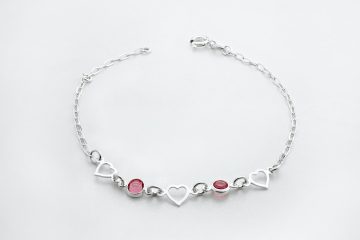Introduction
Bracelets have always been a popular accessory, adding a touch of individuality and style to any outfit. Among the myriad of bracelet designs, the art of braiding stands out, especially the intricate and beautiful Brazilian bracelet techniques. These techniques have gained popularity worldwide, captivating both jewelry enthusiasts and crafters alike. In this article, we will delve into the world of Brazilian bracelet techniques, exploring their history, different braiding patterns, materials used, and tips for mastering this art form.
1. Understanding the History of Brazilian Bracelet Techniques
Brazilian bracelet techniques have a rich cultural heritage closely tied to the country’s indigenous traditions and craftsmanship. The art of braiding has been passed down through generations, preserving the cultural identity of Brazil. These techniques were initially used to create functional accessories, such as belts and straps, which were essential for practical purposes. Over time, the craft evolved, and artisans began incorporating intricate braiding patterns into bracelets, making them both utilitarian and aesthetically pleasing.
2. Exploring Different Braiding Patterns
Brazilian bracelet techniques encompass a wide range of braiding patterns, each with its unique charm. One popular pattern is the “Chevron” or “V” pattern, characterized by a series of diagonal lines that intersect, creating a striking visual effect. Another commonly used pattern is the “Wave” or “S” pattern, which mimics the gentle undulations of water. Additionally, the “Diamond” pattern creates a geometric design that adds a touch of elegance to any bracelet. These patterns are just a few examples of the vast array of possibilities when it comes to Brazilian bracelet techniques.
3. Materials Used in Brazilian Bracelet Techniques
The choice of materials plays a crucial role in the outcome and durability of Brazilian bracelets. Traditionally, artisans used natural fibers such as cotton, hemp, or sisal to create these accessories. However, modern variations often incorporate synthetic threads like nylon or polyester, offering a wider range of colors and textures. Beads, charms, and pendants are also commonly incorporated into Brazilian bracelets, adding a personal touch and enhancing their overall appeal.
4. Getting Started: Essential Tools and Techniques
To begin your journey into mastering the art of Brazilian bracelet techniques, it is important to gather the necessary tools. These include a sturdy work surface, scissors, a ruler or measuring tape, and a selection of threads or cords in various colors. Additionally, you will need a clasp or fastening mechanism to complete your bracelet. Once you have assembled your tools, it’s time to familiarize yourself with the basic techniques, such as the “square knot” and the “half hitch knot.” These fundamental knots form the building blocks for more complex braiding patterns.
5. Step-by-Step Guide: Creating a Basic Brazilian Bracelet
Now that you have a good foundation of the essential tools and techniques, let’s dive into creating a basic Brazilian bracelet using the “square knot” technique. Follow these steps to get started:
Step 1: Measure and cut the cords:
Start by measuring and cutting two cords of equal length, ensuring they are long enough to fit comfortably around your wrist. These cords will form the base of your bracelet.
Step 2: Position the cords:
Place the cords parallel to each other, ensuring they are aligned.
Step 3: Create the first knot:
Take the left cord and cross it over the right cord, forming a loop.
Step 4: Thread the second cord:
Pass the right cord through the loop created by the left cord, from underneath.
Step 5: Tighten the knot:
Gently pull both cords in opposite directions, tightening the knot securely.
Step 6: Repeat the process:
Continue repeating steps 3 to 5, creating a series of square knots until your bracelet reaches the desired length.
Step 7: Finishing touches:
Once your bracelet is the desired length, finish it off by tying a secure knot at the end. Trim any excess cord, leaving a small tail.
Congratulations! You have successfully created a basic Brazilian bracelet using the square knot technique.
6. Mastering Advanced Brazilian Bracelet Techniques
Once you have mastered the basic Brazilian bracelet techniques, you can challenge yourself by exploring more complex patterns and designs. Some advanced techniques include incorporating different knot variations, experimenting with color combinations, and adding beads or charms to enhance the bracelet’s visual appeal. Additionally, you can explore different bracelet styles, such as wrap bracelets or braided cuffs, to expand your repertoire and showcase your creativity.
7. Tips for Perfecting Your Brazilian Bracelet Skills
Mastering any craft takes time and practice, and Brazilian bracelet techniques are no exception. Here are some tips to help you perfect your skills:
1. Start with simple patterns: Begin with basic patterns and gradually progress to more intricate designs as you gain confidence and experience.
2. Practice consistency: Pay attention to the tension and tightness of your knots to ensure a uniform and professional finish.
3. Experiment with color: Play with different color combinations to create unique and eye-catching bracelets. This allows you to express your personal style and creativity.
4. Seek inspiration: Explore online resources, books, and tutorials to gather inspiration and learn new techniques from experienced artisans.
5. Be patient and persistent: Bracelet making is a skill that develops over time. Embrace the learning process and enjoy the journey of improving your craft.
8. Conclusion
Brazilian bracelet techniques offer a captivating blend of tradition, creativity, and craftsmanship. With their intricate patterns and vibrant colors, these bracelets are a testament to the rich cultural heritage of Brazil. By understanding the history, exploring different braiding patterns, and practicing the essential techniques, you can embark on a journey to master the art of Brazilian bracelet making. So gather your tools, select your threads, and let your creativity flow as you create stunning bracelets that reflect your unique style.
FAQs
1. Can I use different materials for Brazilian bracelet making?
Certainly! While traditional materials include natural fibers, modern variations often incorporate synthetic threads, allowing for more color and texture options.
2. Are Brazilian bracelets suitable for all ages?
Yes, Brazilian bracelets can be enjoyed by people of all ages. They make excellent gifts and can be customized to suit individual preferences.
3. How long does it take to master Brazilian bracelet techniques?
The time required to master Brazilian bracelet techniques varies from person to person. With regular practice and dedication, you can begin creating intricate designs within a few weeks or months.
4. Can I sell the Brazilian bracelets I make?
Absolutely! If you have a passion for bracelet making and wish to share your creations with others, you can sell your Brazilian bracelets online or at local markets.
5. Where can I find additional resources to learn more about Brazilian bracelet techniques?
There are numerous online platforms, such as craft websites, forums, and video tutorials, where you can find additional resources and connect with fellow bracelet enthusiasts to enhance your knowledge and skills.




